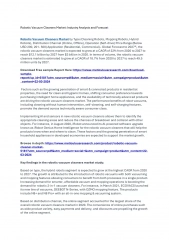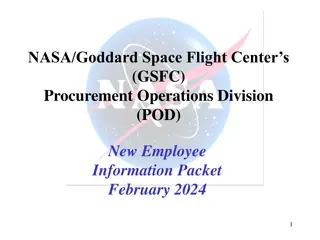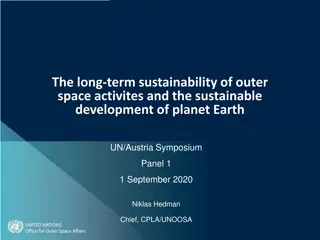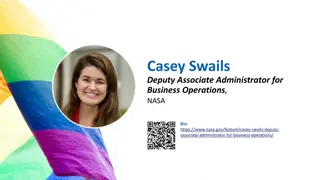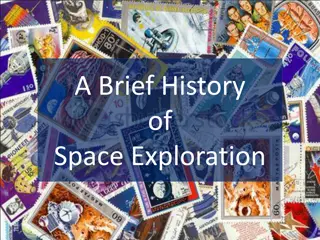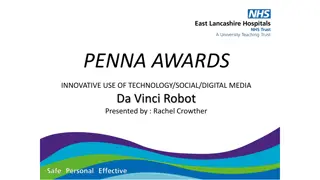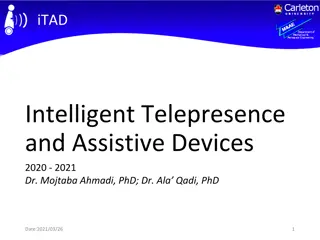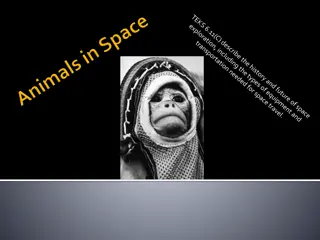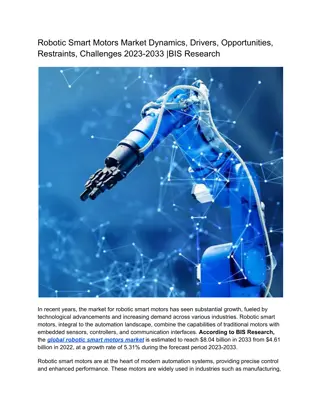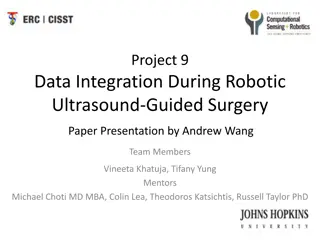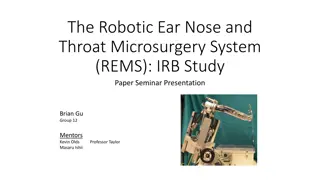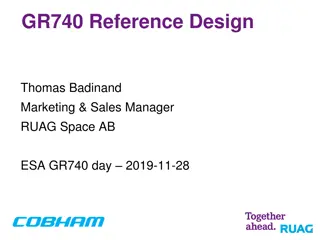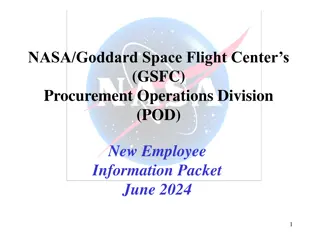Exploration Telepresence: Advancements in Space Mission Concepts and Human-Robotic Development
Delve into the world of space exploration telepresence with panelists Dan Lester, Mark Lupisella, and Kelsey Young, as they discuss their groundbreaking work in galactic star formation, human exploration systems, and geological sciences. Learn about their contributions to NASA's strategic roadmaps, development of space mission concepts, and advancements in teleoperations for Mars exploration. Explore the exciting possibilities of telepresence as an enabling tool for space exploration, drawing from diverse expertise and innovative approaches presented by these esteemed professionals.
Download Presentation

Please find below an Image/Link to download the presentation.
The content on the website is provided AS IS for your information and personal use only. It may not be sold, licensed, or shared on other websites without obtaining consent from the author.If you encounter any issues during the download, it is possible that the publisher has removed the file from their server.
You are allowed to download the files provided on this website for personal or commercial use, subject to the condition that they are used lawfully. All files are the property of their respective owners.
The content on the website is provided AS IS for your information and personal use only. It may not be sold, licensed, or shared on other websites without obtaining consent from the author.
E N D
Presentation Transcript
Exploration Telepresence Exploration Telepresence Almost Like Being There Almost Like Being There Panelists: Dan Lester Mark Lupisella Exinetics NASA Goddard Space Flight Center Kelsey Young NASA Johnson Space Center Moderator: Greg Chirikjian Johns Hopkins University
Dan Lester, Exinetics, dfl@astro.as.utexas.edu Dan s research focus is galactic star formation. As a part of his work, he specializes in developing space mission concepts for astronomical telescopes, and in astronomical instrumentation development, including cryogenic and infrared sensor systems. He was the PI for the SAFIR Vision Mission Study and the SAFIR Human-Robotic Development Team. He works closely with NASA developing new concepts for space exploration telepresence missions, and developing groundwork for telepresence as an enabling tool for space exploration. He has been a key contributor to NASA strategic roadmaps for astronomy and astronomical technology, as well as lunar and planetary science, and has served as senior member on NRC, NASA, and NSF advisory and review committees. He has worked at NASA, the University of Hawaii and the University of Texas for most of his career.
Mark Lupisella, GSFC, mark.l.lupisella@nasa.gov Mark leads Goddard s Advanced Exploration Systems and Architecture support for Human Exploration. He s led studies on Crew-Assisted Sample Return and the use of low-latency teleoperations for the Human Spaceflight Architecture Team and Evolvable Mars Campaign and previously co-led the HAT Cis-Lunar Team and helped develop a 500-day Mars surface operations concept, focusing on science operations. He was a member of the Keck Institute Asteroid Retrieval Mission Study as well a recent participant in a Keck Institute Exploration Telepresence workshop. Mark led proposals to test and further develop a commercial mini-biomolecule sequencer which was recently successfully tested on ISS under the leadership of Johnson Space Center. Mark also worked on Hubble Space Telescope for 10 years, chaired several Failure Review Boards, and has also worked in astrobiology, cooperative robotics, and wearable computing.
Kelsey Young, JSC, kelsey.e.young@nasa.gov Kelsey received her PhD in Geological Sciences at Arizona State University in 2014. She pioneered the use of handheld x-ray fluorescence (hXRF) spectrometers in the field for geologic applications. She has participated in numerous field campaigns investigating geochemistry and mineralogy of terrestrial analog lava flows (Hawai i, Arizona, New Mexico, Iceland, etc.) to understand both lava flow emplacement and evolution as well as post-emplacement alteration processes as an analog for Mars. She has also participated in NASA s Desert Research and Technology Field Studies (D-RATS) analog field test as both a selected Geologist crewmember and member of the science backroom, and has been active in many other projects.
Robotics vs. Human Exploration of Planetary Bodies Robotics vs. Human Exploration of Planetary Bodies (A Few Highlights) Robot Human Apollo 11-16, 1969-72 SkyLab, 1973-79 Space Shuttle, 1982-2011 ISS, 1998 - present Lunakhod, USSR, 1969-77 Mariner 2-10, 1962-73 Viking 1 and 2, 1975/76 Voyager 1+ 2, 1977 NEAR Shoemaker, JHU-APL, 2001 Spirit 2003-10 Opportunity 2003-present Curiosity 2012 present Chang e3/Yutu, CSA, 2013-15 Rosetta, ESA, 2014
Robotics vs. Humans Robotics vs. Humans (Hollywood Version) Robot Human Battlestar Galactica 1978/2004 Saturn 3, 1980 Terminator, 1984 etc I, Robot, 2004 Lost in Space, 1965-68 Forbidden Planet, 1956 The Martian, 2015 Red Planet, 2000 Mission to Mars, 2000 Robison Crusoe on Mars, 1964 Buck Rogers, 1939 Flash Gordon, 1936 It all comes back to: K. Capek s ``Rossum s Universal Robots , 1920
What about Robots AND Humans Working Jointly ? What about Robots AND Humans Working Jointly ? Exploration Telepresence Exploration Telepresence vs. vs. Robots and Humans in Close Proximity Robots and Humans in Close Proximity vs. vs. Purely Robotic or Purely Human Exploration Purely Robotic or Purely Human Exploration
ISRU via ISRU via Teleoperated Teleoperated Self (Architecture from Chirikjian, NIAC 2004 gregc@jhu.edu inspired by K. Ehricke, 1948, A.C. Clarke, 1952, G.K O Neill, 1975; R. Freitas, NASA, 1979; R. Zubrin, 1996) Self- -Replicating Robots Replicating Robots


![❤[READ]❤ Robotic Exploration of the Solar System: Part I: The Golden Age 1957-19](/thumb/21623/read-robotic-exploration-of-the-solar-system-part-i-the-golden-age-1957-19.jpg)
